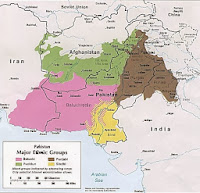Dhr. Seven, Pat Macpherson, Wisdom Quarterly; History Channel, "Ancient Aliens"
 |
| Bamiyan near the real Kapilavastu |
The Ajanta cave complex is not, in fact, the world's oldest series of Buddhist caves. That honor would likely go to the cliff caves and former monastic residences in Bamiyan, Afghanistan, which are 2,600 years old (not in Nepal as we are taught; see RanajitPal.com for startling and controversial details).
The Buddha's extended family, many of whom became Buddhist monastics during his life chose to live nearby and travel to see him in Magadha, India to the east. Prominent family members included:
 |
| Ancient "India" (Maha Bharat) used to extend west to Iran (Persia), when Pakistan and Afghanistan were frontier lands in a region known as Gandhara. They only became separate countries recently after British partition. |
His stepmother (Maha Pajapati, the first Buddhist nun in history), his former wife (Bimba Devi, Subhaddaka, Yasodhara, Rahula-mata, "Rahula's mother," the expert debater Ven. Bhaddakaccānā), his son (Rahula, who became "foremost in doing quiet good"), his half-brother (Nanda), his half-sister (Sundari-Nanda), his father (Suddhodana, not a monastic but enlightened while still a king), and his many cousins (such as beloved Ananda who memorized the "Discourse Collection" or sutras as heard from the Buddha, as well as Anuruddha and others), and at least one famous in-law, Devadatta (the Buddhist "Judas" figure), Yasodhara's brother.
 |
| Physical descriptions of Siddhartha with curly black hair, golden skin, and blue eyes make him far more likely to be Central Asian rather than Indian as we imagine it today. |
 |
| The former northwest Indian frontier |
His biological mother, Maya Devi, who passed away a week after his birth, was reborn in a world called Tavatimsa, where the Buddha visited her to teach her the liberating Dharma he taught the rest of his family on Earth. (Maya Devi's sister and co-wife, Maha Pajapati, had both married Siddhartha Gautama's father, King Suddhodana; she adopted him right away, raising the prince, heir-apparent, and future Buddha as her own son).
Many family members, particularly females, would likely have chose to remain in the vicinity of ancient Kapilavastu, the capital of the Shakya clan's territory (janapada), after ordaining. They would have practiced the Buddha's teachings in familiar company, adopting a wandering ascetic ethos with monasteries serving in a capacity more like California's missions, with itinerant religieux traveling between them up the Silk Road through a prosperous crossroads (now impoverished, war torn Afghanistan) These connected caves alongside massive Buddha statues contain the world's oldest oil paintings.
(C2C) Michael Cremo is not the only "forbidden archeologist." Johnathan Gray (beforeus.com) from Australia talks about amazing discoveries that get at explanations beyond mainstream filtered-science, which seems bewitched by its "consensus reality" that ignores sacred histories (such as the Brahminical Vedas or Buddhist Jatakas), extraterrestrial visitations, mythologies, and discoveries with interpretations such as a former global civilization and advanced technologies superior to what we have now. The world and human life on it is aeons old.
But how the Ajanta Caves was created remains a mystery. Like the great pyramids of Egypt and precise stone structures all around the world -- like the world's largest pyramid in Bosnia -- they could not have been constructed by humans without extraterrestrial assistance. "Visitors" with advanced technology, whether remembered as mythical figures (akasha-devas, Sakka, the catumaharajikas, asuras, nagas, garudas, yakkhas, and gandharvas -- or "shining ones" from space, the Four Great Sky Kings, titans, reptilians, avians, celestial ogres, and celestial messengers) or as verifiably "ancient aliens" depicted on the eponymous History Channel program.
Of course, it is more fun and esteem-building to imagine our clever forbears, we humans with primitive tools, created these astounding masterpieces without help, direction, or advanced technology. Homo sapiens, hooray. Shining ones (devas)? We'll see it when we believe it, because it will seem to take an act of faith to see what the evidence has been trying to tell us for centuries.
































































































































































































































No comments:
Post a Comment